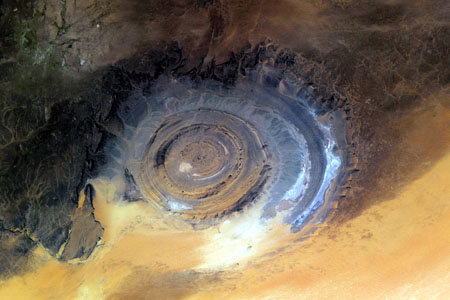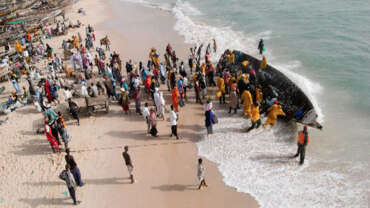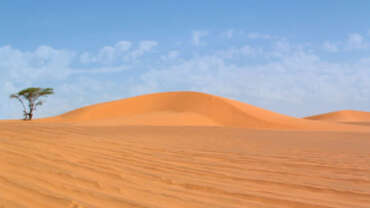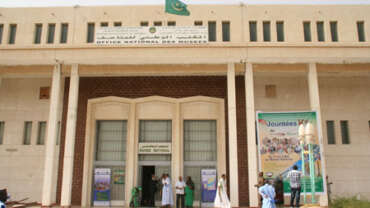Discover & Explore Mauritania
Handicraft market
In Nouakchott, at the market, let you find clothes and other fabrics (The marché Capitale, the largest in the city, is located by Kennedy Avenue). Nearby, at the central women’s handicraft shop, you will find many traditional items made by women
Behind the fort of Ksar, let yourself visit the workshops of the handmade carpet factory of Matis,. The National Carpet Office is in the same area. Visit its factories and training center. You can still order an original carpet and have it delivered at home.
In front of the Moroccan mosque south of the marché Capitale, enjoy the freshness of the fruit market. If you go down to the south, you’ll find molten glass pearls and Malian batik loincloths. 7 km south of Nouakchott, on the road to Rosso, the jewelery handymen market offers a comprehensive selection of jewelry. Go and visit theses manufacturing workshops. In Oualata, go to the Women’s House where you can see handicrafts from ancestral traditions.
National Museum
The National Museum is housed in a forty-year-old building built by Chinese cooperation. This building is housing the Mauritanian Institute of Scientific Research, the Mauritanian Manuscripts Conservation Center and the National Library.
The museum displays us, beyond the showcases, what were the living conditions of the populations who lived in the country for millennia, through the exhibition of miniatures and objects of everyday life and tools and pictures taken during excavations. The latter were mainly carried out in Koumbi Saleh, the former capital of the Ghana Empire, in Aoudaghost, the main trading post on the caravan route for more than five centuries, and in Azougui, the former capital of the Almoravids. Some of these objects, fortuitously found by Mauritanians, have been brought to the museum, demonstrating the respect they have for their heritage.
The main door leads to a well-equipped room offering a modern learning environment for different segments of the local community and all categories of visitors: children, families, researchers, specialists, etc. The Museum also aims to strengthen the educational and cultural mission by contributing to the collection of art paintings.
In the waiting room, there are showcases. Inside one of them works of the great scholar Mohamed Salem ould Adoud are exhibited. Nearby, some instruments of music, as well as a statue of a married woman, of a dazzling beauty, wearing a black veil called Nîla. Inside, some rare masterpieces of sculptures, some paintings and everything related to cultural heritage. This room houses most often scientific works, works of art, manuscripts of religious sciences like the treaties of Khalil and its commentaries, the Islamic conquests (El Bedoui)…
Hollow and polished stones of old models serving as schoolboys’ inkwell. Similarly, the museum provides information to researchers, students and others. Ahmed Salem, an old man who often comes to visit the museum says: “this place serves as a cultural center and is a mirror of the society; it reflects the influence of our history before and after independence”.
The museum also focuses on highlighting the specificities of each region of the country, thanks to a variety of exhibitions that reflect the overall context of the country’s history and highlight its geographical and cultural unity.
Among the precious exhibits are: a chain mail found in the region of Koumbi Saleh, potteries of the region of Mederdra, jars of Tegdaouest, (discovered during the excavations led by Koltermann in 1998, on the site of the fort d’Arguin). Also in the showroom, are exhibited the photos of the flood occurred in 1932 in Nouakchott and of a necropolis of the Ain en Nouss.
The men buried in the necropolis dated 3 965 BP wore pearls necklaces of Andara or stone, and were accompanied by numerous and rich pottery of various traditions, millstones, wheels and tiny arrow heads.
Port of fishing
Fisheries are one of the most important resources in the country. The Mauritanian coasts are reputed to be among the most fish-bearing in the world. But here is the kingdom of artisanal fishing. A huge fleet of traditional wooden canoes (several hundred) painted in bright colors, with small engines discharge tons of fish on the beach.
Hundreds of people, many of them are Senegalese immigrants; work in conditions of another era. The return of fishing is usually between 4:30 pm and 6:30 pm. Time that coincides with the sunset. The canoes are then hoisted on logs or empty gas cylinders, which allows their movement on the beach.
Nouadhibou Fishing Port
Located at 525 km north of Nouakchott, Nouadhibou (95,000 inhabitants), called Port-Étienne, during the colonial era, was originally the first African stopover of the Aéropostiale. This is where part of Antoine de Saint-Exupéry’s “Terre des hommes” action takes place. The explosion of the fishing industry has transformed the face of the city, with the development of the autonomous port for industrial fishing as well as the artisanal port intended to Mauritanian and Senegalese boatmen. Surprisingly, the bay is a real cemetery of boat wrecks. Nouadhibou is the gateway to Mauritania from Morocco.
Banc d’Arguin Park
The Banc d’Arguin, a natural sanctuary raised to the rank of world heritage, where land and sea blend together, hosts millions of migratory birds, the largest concentration of monk seals persecuted since the 15th century, sea turtles , cetaceans, but also golden jackals, gerbils, striped hyenas etc. This site is one of the largest bird breeding areas in Africa. There are more than two million individuals, divided into more than a hundred species of birds (pelicans, flamingos, herons…
The Amatlich
Located north-west of the city of Atar, the erg Amatlich is a dune field of 13 kilometers wide on average and 400 kilometers long. These dunes lie between the black mountains of the Adrar and extend to the Atlantic Ocean. This long strip of dunes, with no end in sight, is the longest of all the South of the Adrar. The Amatlich, however, is not only this endless stretches of majestic dunes that makes the feeling of freedom more intense, and the taste of adventure more spicy.
It is also a very beautiful and vast environment of a wide variety of Saharan landscapes. In addition to the endless dunes, you will have the chance to see green palm groves, canyons and cliffs. Visit, on the west side of the erg, the beautiful palm grove of Azoueiga. A hike, in one of the most beautiful landscapes of Mauritania, would be more efficient with nomadic guides for a real human adventure.
Chinguetti
Formerly a caravan city listed as World Heritage, Chinguetti has acquired a great prestige by its spiritual influence to that an extend that it is regarded as the seventh holy city of Islam. This small oasis is renowned for its mosque, its old houses of banco and stones, built from the twelfth century with its libraries where kept for centuries thousands of unpublished manuscripts of great cultural and scientific value. The minaret of Chinguetti (surmounted by a stylized ostrich egg) has become the symbol of Mauritania, which until recently was called the “Bilad Chinguitt”. Some sources state that the foundation of Chinguetti dates back to 660 AH (1261).
This ancient city was a center of religious and cultural influence from which Mauritanian scholars spread Islam and Arab-Muslim culture throughout West Africa. Among the disciplines studied were theology, poetry, philosophy and law taught according to the Sunni rite and Maliki School. Chinguitty contains countless patrimonial opportunities that thousands of tourists and men of culture come to discover every year.
Ouadane
The city of Ouadane is built on the side of a cliff (sandstone-argillaceous) belonging to the formation of the interlayer continental. Escalated by a vertiginous pile of ruins, the city reveals from a distance its minaret. The city is 175km north-east of Atar (the regional capital of Adrar).
Like the ancient cities of the Adrar, the history of the city of Ouadane can be subdivided into three major periods: pre-foundation period of the city with Bafours settlements, (536 AC / 1141-42 H); period of Islamisation from the twelfth century with the conquest of the Adrar by the Almoravids and Almohads, the arrival of the three pilgrims founders of the city, prosperity of the city with Portuguese trading post and the contemporary period (the Emirate of Adrar, colonization, independence).
Listed as a world heritage, Ouadane has experienced intense cultural and scientific activity : there were libraries with manuscripts dealing with all areas of knowledge. One street would have housed 40 scholars.
Atar
Birth of the city of Atar. Atar was founded by the Smacid tribe, so it is useful to take a look at the history of the arrival of this tribe in Adrar and the adventures that led to the birth of their Ksar (Atar) in the “Baten” of the Adrar. Their ancestor, Yahya El Kebir Alghalghamy would have left Morocco after the war between Idrissides and Alawites. He settled first in Algeria, before being attracted by the cultural influence of Chinguetti. His arrival is located in the seventh century.
Chems Eddine, the eponymous ancestor of Smacid tribe, is one of the sons of Sharif Yahya, whose origin goes back to the fourth Caliph of Islam, Ali Ibn Abu Taleb (according to a genealogy advanced by N’Tahah). One of the sons of Chems Eddine had been appointed as an Imam of the Chinguetti Mosque, which was a great honor, but after a conflict between Laghlal and Idawali tribes, the founders of the new Chinguetti, the smacid imamat was questioned and either paradoxically or after a compromise, a Ghallaoui (from laghlal) was appointed to direct the mosque of the city.
The Smacid decided then to explore the Baten and Dhar region, and finally left Chinguetti. The sons of Ahmed Ould Chems Eddine settled in Atar, while those of his brother Mohamed Fadel settled in Aoujeft (80 km, southeast of Atar).
The newcomers settled on the plateau located on the road to Azougui before choosing a terrain elevation – in order to avoid the floods – to build their new Ksar. (In 1984, during the catastrophic floods that struck the city of Atar, only the old Ksar remained intact and all around its mosque). Good relations united the tribes of Ideichilly the former inhabitants of the region and Smacid.
* According to the researcher Abdel Weddoud Ould Cheikh, the word “atar” means road in Azer language or new city in Berber.
Adrar
Beam point of the outreach of the Almoravids, the wilaya is famous for its palm groves, its annual guetna (treatment of fresh dates) and its gardens.
Its capital, Atar, is the starting point of many treks. The city presents, on one side, the old ksar with narrow streets and multiple escapades, and on the other, the recent city with wide straight streets. Created in the 13th century, it was, during the period of penetration and colonial occupation, an important French strategic position and one of the main stages of the Trans-Saharan track.
Nouakchott
Bordering the Atlantic Ocean, Nouakchott is the capital of the country since 1957. Nouakchott is the symbol of the multicultural dimension of Mauritania. In fact, an intermingling of different Negro-African and Arab-Berber ethnic groups provides this city uniqueness in Africa. And all over the city there is a large concentration of accommodation, apartments, modern buildings, restaurants and shops of all kinds. A peculiarity of Nouakchott is that its groceries and clothing stores are open until very late at night.
The artisanal fishing port, the vegetable gardens (oases of several hectares in the heart of the city), the Central Market and the National Museum are the main centers of interest of Nouakchott. And of course not to be missed, the Ksar, the oldest neighborhood of the city, where the aviator Saint-Exupéry spent his nights.
Several walks can be done near the city on the Atlantic coast and several tours are possible from Nouakchott: by the beach towards the Banc d’Arguin National Park, by the “route de l’Espoir” towards the hinterland and by the northern roads to Nouadhibou or Atar.
Mauritanian desert
Discovering the desert
Walking in the Mauritanian desert is a quest for the absolute, a personal challenge and an inner spiritual journey where each step is closer to self-knowledge.
Mauritania has remarkable desert landscapes, sometimes in the form of conquering or fixed sand dunes, majestic or timid, sometimes in the form of stones which generates landscapes that conceal, under an apparent uniformity, great differences.
It can be massive sandstone with picturesque nipples, carved rocks, regs like the Inchiri or the Tiris, powerful tabular cliffs like the Adrar Ridge with its ravines, canyons, caves, etc. These landscapes are particularly characteristic of the regions of Adrar, Tagant, Hodh Chargui, Hodh Garbi and Assaba.
These splendid landscapes, very varied and rarely monotonous, are intersected by zones of vegetable, animal and human lives, in the form of camps or permanent oases. In many cases, these constitute magnificent landscapes: oasis of Terjit, Kasr Torchane, Toungat, Agueni, etc. in the vicinity of Atar and Kamour, Guérou, Kankossa in the neighborhood of Kiffa.
The extremely flat Saharan peneplains (Karet, Yetti, Ghallamane, Amsaga) extend from the eastern border to the northeastern borders of the country. Occasionally, isolated mounds are the remains of ancient reliefs: the jibals of the Adrar and Kediet ej-jill.
There are ergs oriented from north-east to south-east: the ergs of Iguidi, Al Hamami, Azeffal and Akchar. To the north, the Sahara (Tiris Zemmour, Dakhlet Nouadhibou) was the domain of the great nomads now established mostly in the cities of Zouerate, F’Derick and Nouadhibou.
The desert visiting lasts an average of eight days and may take the form of hikes using different means of transport: on foot, by camel or in a 4×4 vehicle. The absence of any accommodation equipment in the places visited implies that the accommodation may take the form of bivouacs by using removable and transportable tents.
The contemplation of the natural landscapes can be associated with rest stops in the inhabited places that allow to come into contact with the resident populations and to experience their way of life.
They also allow to visit existing historical and cultural sites.
Desert discovery tours are increasingly enhanced by supplements such as:
– A train trip on “Train du désert ” across all or a portion of the railway from Zouerate to Nouadhibou;
– Sport fishing with accommodation in a campsite near Nouhadibou
– The falcon hunt an Increasingly trips attendance
– Stays or cultural tours, with themed stays and visits to listed world heritage ancient cities.
– Stays and tours of eco-tourism-only type, thanks to the visit of both parks of Banc d’Arguin and Diawling.
Richat structure
Located in Mauritania, the Richat structure or “the eye of Africa” is an exceptional geological structure located in the Sahara Desert.
Approximately 50 kilometers in diameter, it has longtime intrigued scientists before they find its origin. If you fly over the Mauritanian Sahara one day, you will certainly see an amazing structure stand out from the landscape, like an enormous eye pointing to the sky, “the eye of Africa”. More known under the name of structure or dome of Richat, this formation is located near the city of Ouadane , it can be seen from the skies, and even from the space.
Discovered a long time ago, the structure of Richat was visited since the 1950s by scientists before being revealed on a large scale by one of the American space missions, the Gemini. At that time, the astronauts were greatly marveled at the atypical characteristics of the structure. Superimposed circles of several tens of kilometers in diameter forming a kind of a giant ammonite…






